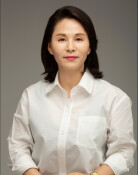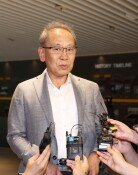The Birth of the Centrist Alliance Party
The Birth of the Centrist Alliance Party
Posted June. 05, 2007 04:57,
The New Party for Centrist Reform and Alliance and the Democratic Party announced their merger on June 4 and launched the process of political regrouping. DP leader Park Sang-cheon and his counterpart Kim Han-gill decided to name the new party the Centrist Alliance Party after publicizing how to form the new party in the National Assembly on the same day.
Competition for leadership in the new party and disputes over ways and means for the merger are expected to become more heated as liberal forces restructure themselves from three parties of the Uri Party, the New Party for Centrist Reform and Alliance, and the Democratic Party, to a two party system of the Uri Party and the Centrist Alliance Party.
The new party will control 34 parliamentary seats combining the DP`s 14 seats, which include Rep. Yoo Seon-hos, an Uri defector who yesterday joined the alliance, and the Uri splinter groups 20. This number is expected to increase when the party recruits legislators who have already left the Uri Party or plan to quit the party.
The two parties agreed to hold an inaugural convention next month after registering their merger and the creation of the new party with the National Election Commission by June 15 by setting up a working committee for the new party consisting of six people from their parties.
In their declaration, the two parties said, They will change the divided politics under the current administration. Also, they urged the joining of all centrist liberals who believe the Grand National Party should not rule the country and the people.
The New Party for Centrist Reform and Alliance and the Democratic Party will likely increase their membership before registering the new party by attracting Uri Party legislators whose electorates are in Gwangju and South Jella province, independent legislators who bolted from the Uri party, and some Uri lawmakers who are not pro-Roh Moo-hyun.
Experts analyzed that the two parties decision to register the new party on June 15 was made to pressure the Uri Party, which set its date as June 14.
The mood within the Uri Party at news of the alliance was dismal. Some legislators who declared they would leave the party to protest Park Sang-cheons mini integration plan decided to remain in the party. Therefore, the plan of creating new areas by party leadership will be inevitably disrupted. In addition, legislators who declared their withdrawal pressured the party by saying that, If the leadership fails to come up with a breakthrough, they will not change their decision.
The Uri leadership emphasized that the chairman of the Democratic Party didnt remove a clause on membership restrictions to a merger party to control the exodus of its lawmakers. In the meantime, the leadership criticized the DPs decision to create a new party as a minor integration for the general election through securing vested interests.
Furthermore, Jung Se-kyun, chairman of the Uri Party, criticized that the Democratic Party deleted a clause in the agreement to actually keep it alive, and to deceive the general public at a meeting of the chairman of the supreme council.
The problem faced by the new party is that even after the two parties announced their merger, they applied different approaches toward the clause. Democratic Party Chairman Park explained in a news conference that, We never repealed the clause and we didnt include the clause in the declaration because it is not mandatory to mention the clause.
However, Kim Han-gill reaffirmed the position against the clause, saying that, What is clear is written in the agreement and content, and we will not accept any moves against the agreement.
jin0619@donga.com







